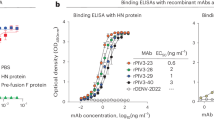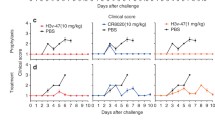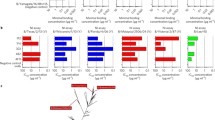Summary
The relative importance of the host immune response to various antigenic and functional sites on the HN glycoprotein of Sendai (6/94) virus for protection in vivo, was evaluated in mice passively immunized with monoclonal antibodies to HN and then intranasally challenged with infectious virus. Five neutralizing monoclonal antibodies reacting with distinct antigenic sites and exhibiting different reactivity patterns were selected. All of them were able to prevent entirely the growth of virus in the lungs of experimental animals injected with appropriate dilutions of monoclonal antibody. The calculation of correlation coefficients between the reduction of virus in the lungs of immunized mice and the amount of antibody, expressed in terms of hemagglutination inhibition, hemolysis inhibition or neutralizing units, showed a high degree of correlation (r=0.89) with neutralization and a lack of correlation (r=0.44) with hemagglutination inhibition. In parallel a minimum threshold value for protection equivalent to 2×103 neutralizing units per mouse was determined independently of the mechanism(s) by which monoclonal antibodies mediated the neutralization of the infectivity.
On the HN glycoprotein of Sendai (6/94) virus we could not individualize a critical site for successful immune recognition by antibodies although the characteristics of an “ideal protective monoclonal antibody” have also been defined.
Similar content being viewed by others
References
Beraud F, Kessler N, Aymard M (1984) Contribution of monoclonal antibodies to the study of parainfluenza virus antigens. Dev Biol Stand 57: 257–267
Giraudon P, Wild F (1985) Correlation between epitopes on hemagglutinin of measles virus and biological activities: passive protection by monoclonal antibodies is related to their hemagglutination inhibiting activity. Virology 144: 46–58
Hosaka Y (1980) Separation of Sendai virus glycoproteins by using glutaraldehydetreated erythrocytes and preparation of monospecific antisera against the glycoproteins. Infect Immun 30: 212–218
Iorio RM, Bratt MA (1983) Monoclonal antibodies to Newcastle disease virus: delineation of four epitopes on the HN glycoprotein. J Virol 48: 440–450
Kessler N, Bardeletti G, Aymard M (1977) The neuraminidase of human parainfluenza 1 virus (HA2 virus). J Gen Virol 37: 547–556
Kessler N, Aymard M, Calvet A (1979) Study of a new strain of paramyxovirus isolated from wild ducks: antigenic and biological properties. J Gen Virol 43: 273–282
Kessler N, Suiphon E, Aymard M (1983) Intérêt de la méthode ELISA appliquée au diagnostic des infections à virus parainfluenza. In: 4ème Colloque Franco-Soviétique sur la Grippe, Paris, 20–22 avril 1982. Les Editions I.N.S.E.R.M., Paris, p 45–59
Merz DC, Scheid A, Choppin PW (1980) Importance of antibodies to the fusion glycoproteins of paramyxoviruses in the prevention of spread of infection. J Exp Med 151: 275–288
Olmsted RA, Elango N, Prince GA, Murphy BR, Johnson PR, Moss B, Chanock RM, Collins PL (1986) Expression of the F glycoprotein of respiratory syncytial virus by a recombinant vaccinia virus: comparison of the individual contribution of the F and G glycoproteins to host immunity. Proc Natl Acad Sci USA 83: 7462–7466
örvell C, Norrby E (1977) Immunologic properties of purified Sendai virus glycoproteins. J Immunol 119: 1882–1887
örvell C, Grandien M (1982) The effects of monoclonal antibodies on biological activities of structural proteins of Sendai virus. J Immunol 129: 2779–2787
Paterson RG, Lamb RA, Moss B, Murphy BR (1987) Comparison of the relative roles of the F and HN surface glycoproteins of the paramyxovirus simian virus 5 in inducing protective immunity. J Virol 61: 1972–1977
Portner A (1981) The HN glycoprotein of Sendai virus: analysis of site(s) involved in hemagglutinating and neuraminidase activities. Virology 115: 375–384
Portner A, Scroggs RA, Metzger DW (1987) Distinct functions of antigenic sites on the HN glycoprotein of Sendai virus. Virology 158: 61–68
Rydbeck R, Löve A, Norrby E (1988) Protective effects of monoclonal antibodies against parainfluenza virus type 3 induced brain infection in hamsters. J Gen Virol 69: 1019–1024
Stott EJ, Ball A, Young KY, Furze J, Wertz GW (1986) Human respiratory syncytial virus glycoprotein G expressed from a recombinant vaccinia virus vector protects mice against live virus challenge. J Virol 60: 607–613
Taylor G, Stott EJ, Bew M, Fernie BF, Cote PJ, Collins AP, Hughes M, Jebbett J (1984) Monoclonal antibodies protect against respiratory syncytial virus infection in mice. Immunology 52: 137–142
Thompson SD, Portner A (1987) Localization of functional sites on the hemagglutinin-neuraminidase glycoprotein of Sendai virus by sequence analysis of antigenic and temperature-sensitive mutants. Virology 160: 1–8
Walsh EE, Schlesinger JJ, Brandriss MW (1984) Protection from respiratory syncytial virus infection in cotton rats by passive transfer of monoclonal antibodies. Infect Immun 43: 756–758
Wofsy L (1983) Methods and application of hapten-sandwich labeling. In: Langone JJ, Van Vunakis H (eds) Immunochemical techniques, part E. Academic Press, New York, pp 472–488 (Methods in enzymology, vol 92)
Wolinsky JS, Waxham MN, Server AC (1985) Protective effects of glycoprotein-specific monoclonal antibodies on the course of experimental mumps virus meningo-encephalitis. J Virol 53: 727–734
Yewdell J, Gerhard W (1982) Delineation of four antigenic sites on a paramyxovirus glycoprotein via which monoclonal antibodies mediate distinct antiviral activities. J Immunol 128: 2670–2675
Author information
Authors and Affiliations
Rights and permissions
About this article
Cite this article
Piga, N., Kessler, N., Layani, MP. et al. Correlation between the reactivity patterns of monoclonal antibodies to distinct antigenic sites on HN glycoprotein and their protective abilities in Sendai (6/94) virus infection. Archives of Virology 110, 179–193 (1990). https://doi.org/10.1007/BF01311287
Received:
Accepted:
Issue Date:
DOI: https://doi.org/10.1007/BF01311287




